Genetic Algorithms
-
- The Natural Order Maritime Reporter, Jan 2001 #44
The impact of increasingly stiff rules from legislators regarding ship engine emissions combined with ever increasing demands from ship and boat owners of better life-cycle performance andfuel economy has placed the onus squarely upon the diesel engine manufacturing community to continuously improve products and systems.
While the diesel engine community has responded in kind with a variety of enhanced designs and concepts (see Carnival Spirit story, page 50), there is a revolution spurred by evolution brewing in academia which promises to, at the very least, arm diesel engine makers with a system to quickly and cost effectively optimize current diesel engine performance, and to possibly even help to reshape the diesel engine's inner and outer appearance in the name of improving performance.
A Design For The Ages Developed by Paris-born Rudolf Diesel, the diesel engine today — despite numerous refinements, enhancement and improvements — remains very similar to the prototype produced in 1893.
The diesel engine is a timeless power unit that used the newly discovered principles of thermodynamics as a potential replacement to the then efficient gasoline engine. In 1885, Diesel set up his first shop-laboratory in Paris and began his 13- year process of inventing the engine that would bear his name. At Augsburg, on August 10, 1893, Diesel's prime model, a single 10-ft. iron cylinder with a flywheel at its base, ran on its own power for the first time.
Diesel spent an additional two years improving the original design, and on the eve of 1897 demonstrated a model that boasted a theoretical mechanical efficiency of 75.6 percent, as opposed to the prevailing efficiency of the steam engine of approximately 10 percent or less.
On January 28, 1898, B&W acquired the rights to use the patent of Diesel. The first engine was delivered by the company in 1904 to N. Larsens Vognfabrik in Copenhagen to produce electricity for lighting. The engine type was a DM140, i.e. a one cylinder with an output of 40 hp at 180 rpm. The cylinder diameter was 320 mm and the stroke was 490 mm. The demand for diesel engines in marine applications quickly grew, and circa 1909 B&W engineers developed a reversing mechanism, which enabled the engines to run in both directions. The following year, diesel engines were being built for the world's fist oceangoing motorship, M/S Selandia.
Survival of the Fittest Improving upon Rudolf Diesel's initial design has been non-stop work, and in recent years much effort and countless millions of dollars have been invested to enhance performance and reduce emissions.
Legislation demanding lower emissions and customer demand for more sturdy, fuel efficient products have been the primary drivers of diesel engine development, with the former having more tangible and immediate impact.
The process of simulating diesel engine designs via computer is hardly a new development, as various levels of research, development, and testing have been deployed by engine makers for many years. But the specter of focusing on the entire engine, specifically tweaking any given number of factors while seeking the optimum performance parameters that cuts emissions while improving fuel economy and life-cycle performance, among others, was a process that — in real world trials could take practically forever — and in the computer lab could quickly clog even the most prolific of machines.
Scientists at the University of Wisconsin have developed what they believe to be the best approach.
Using the recently developed KIVAGA computer code, the researchers are performing full-cycle engine simulations within the framework of a Genetic Algorithm (GA) global optimization code. In short, Dr. Rolf D. Reiz and his colleagues have devised a computational computational design methodology for the optimization of internal combustion engines with respect to a large number of parameters (injection timing, injection pressure rate-shape, combustion chamber design, turbocharging, etc.) The interesting aspect of the study, which it should be noted has currently only been conducted for diesel truck engines, is that it combines computer technology with Darwin's Theory of Evolution. Genetic Algorithms — which have been successfully applied to design problems ranging from laser systems to reinforced concrete beams — are global search techniques based on the mechanics of natural selection, combining a "survival of the fittest" approach with some randomization and/or mutation. For the purpose of diesel engine optimization study, "mutating genes" can be thought of as tweaking the variables. In the study, the machines literally competed against one The results recorded reported and confirmed in a real-world test showed significantly (approx. 15 percent) less fuel consumption than the baseline engine, with 70 percent less NOx and 50 percent less soot.
another, with the strongest surviving and serving as the basis for future generation designs. The process was repeated until the evolutionary winner, which optimized fuel efficiency and performance while cutting emissions, emerged. Ordinary GA's demand hundreds of "organisms" to be evaluated in each generation, but given the time consuming process of evaluating the diesel engine cycle, the researchers needed a better, more time-efficient way to test and evaluate. The present study uses Micro-Genetic Algorithm, which operates similarly in that it works on a family, or population of designs, yet it allows for a very small population size. For example, in a recent study, the design factors tested include: boost pressure, EGR Level, Start of Injection, Injection Duration, Mass in First Pulse and Dwell Between Pulses. The results recorded, reported and confirmed in a real-world test showed significantly (approx. 15 percent) less fuel consumption than the baseline engine, with 70 percent less NOx and 50 percent less soot. The present methodology provides a useful tool for engine designers investigating the effects of a large number of input parameters on emissions and performance
-
- New Propeller Optimization Process Can Analyze 10,000 Designs a Day Maritime Reporter, Mar 2014 #18
this first test case has been performed, MARIN is continuing to explore the automated propeller design. The process will be sped up by the use of genetic algorithms and integrated into the daily design process. The EU project SONIC already presents the next challenge: optimizing for both high efficiency,
-
 )
March 2024 - Marine Technology Reporter page: 33
)
March 2024 - Marine Technology Reporter page: 33regulated industry in the world.” How- ever, commercial success depends on many factors, not least a predictable OPEX. Over the past four years, SMD has worked with Oil States Industries to calculate cost per tonne ? gures for prospective customers. Patania II uses jet water pumps to Oil States’
-
 )
April 2024 - Maritime Reporter and Engineering News page: 14
)
April 2024 - Maritime Reporter and Engineering News page: 14Book Review Approach to Meeting Underwater Radiated Noise Limits Def ned By Raymond Fischer uantitative underwater radiated noise limits will construction inspections, 5) possible training with respect to be developed shortly by IMO, and/or countries salient design/construction essentials, 6) compliance
-
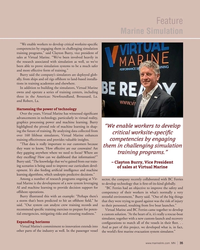 )
February 2024 - Marine News page: 35
)
February 2024 - Marine News page: 35Feature Marine Simulation “We enable workers to develop critical worksite-speci? c competencies by engaging them in challenging simulation training programs,” said Clayton Burry, vice president of sales at Virtual Marine. “We’ve been involved heavily in the research associated with simulation as well
-
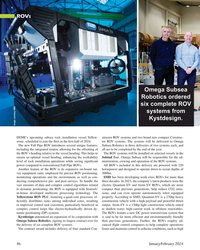 )
January 2024 - Marine Technology Reporter page: 46
)
January 2024 - Marine Technology Reporter page: 46ROVS Omega Subsea Robotics ordered six complete ROV systems from Kystdesign. Image courtesy SMD DEME’s upcoming subsea rock installation vessel Yellow- structor ROV systems and two brand new compact Construc- stone, scheduled to join the ? eet in the ? rst half of 2024. tor ROV systems. The systems
-
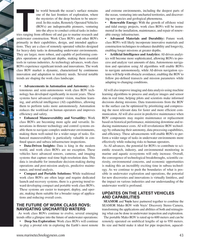 )
January 2024 - Marine Technology Reporter page: 43
)
January 2024 - Marine Technology Reporter page: 43he world beneath the ocean’s surface remains and extreme environments, including the deepest parts of one of the last frontiers of exploration, where the ocean, venturing into uncharted territories, and discover- the mysteries of the deep beckon to be uncov- ing new species and geological phenomena. ered.
-
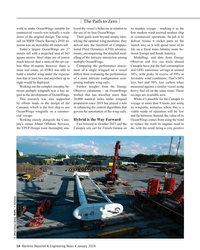 )
January 2024 - Maritime Reporter and Engineering News page: 14
)
January 2024 - Maritime Reporter and Engineering News page: 14The Path to Zero work to make OceanWings suitable for lyzed the vessel’s behavior in relation to its maiden voyage – marking it as the commercial vessels was actually a scale the use of its four OceanWings. ? rst modern wind assisted modern ship down of the original design. The wing- Their goals went
-
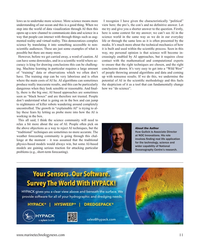 )
November 2023 - Marine Technology Reporter page: 11
)
November 2023 - Marine Technology Reporter page: 11lows us to undertake more science. More science means more I recognize I have given the characteristically “political” understanding of our ocean and this is a good thing. When we view here; the pro’s, the con’s and no de? nitive answer. Let step into the world of data visualization through AI then
-
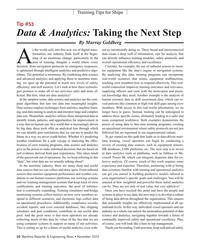 )
November 2023 - Maritime Reporter and Engineering News page: 10
)
November 2023 - Maritime Reporter and Engineering News page: 10Training Tips for Ships Tip #53 Data & Analytics: Taking the Next Step By Murray Goldberg s the world sails into this new era of digital trans- out us intentionally doing so. These broad and interconnected formation, our industry ? nds itself at the begin- data create a deep well of information, ripe for
-
 )
September 2023 - Marine Technology Reporter page: 48
)
September 2023 - Marine Technology Reporter page: 48MTR 100 Valepor Totnes, Devon, UK President/CEO: Matthew Quartley # of Employees: 112 www.valeport.co.uk Valeport is a manufacturer of oceanographic and hydro- land’s South West coast, the new technique is a collaboration graphic instruments. Based in the UK, the privately owned, of Valeport and HydroSurv
-
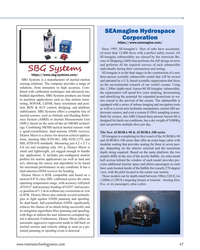 )
September 2023 - Marine Technology Reporter page: 47
)
September 2023 - Marine Technology Reporter page: 47SEAmagine Hydrospace Corporation https://www.seamagine.com/ Since 1995, SEAmagine’s ? eet of subs have accumulat- ed more than 12,000 dives with a perfect safety record. All SEAmagine submersibles are classed by the American Bu- reau of Shipping (ABS) that performs the full design reviews and performs
-
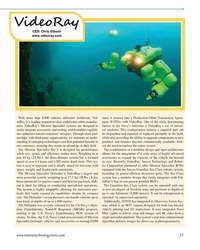 )
September 2023 - Marine Technology Reporter page: 37
)
September 2023 - Marine Technology Reporter page: 37VideoRay CEO: Chris Gibson www.videoray.com With more than 4,000 vehicles delivered worldwide, Vid- since it entered into a Production-Other Transaction Agree- eoRay is a leading inspection-class underwater robot manufac- ment (P-OTA) with VideoRay. One of the many determining turer. VideoRay’s Mission
-
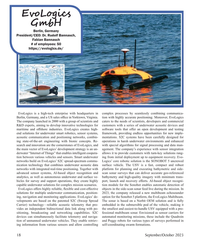 )
September 2023 - Marine Technology Reporter page: 18
)
September 2023 - Marine Technology Reporter page: 18EvoLogics GmbH Berlin, Germany President/CEO: Dr. Rudolf Bannasch, Fabian Bannasch # of employees: 50 https://evologics.de/ EvoLogics is a high-tech enterprise with headquarters in complex processes by seamlessly combining communica- Berlin, Germany, and a US sales of? ce in Yorktown, Virginia. tion
-
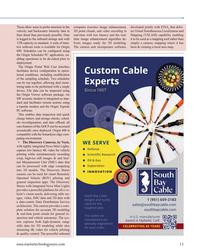 )
September 2023 - Marine Technology Reporter page: 13
)
September 2023 - Marine Technology Reporter page: 13These allow users to probe structure in the computer executes image enhancement, developed jointly with EIVA, that deliv- velocity and backscatter intensity data in 3D point clouds, and video encoding in ers Visual Simultaneous Localization and ? ner detail than previously possible. Data real-time
-
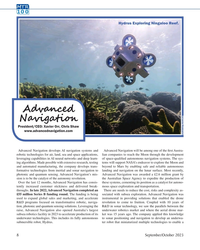 )
September 2023 - Marine Technology Reporter page: 8
)
September 2023 - Marine Technology Reporter page: 8MTR 100 Hydrus Exploring Ningaloo Reef. Advanced Navigation President/CEO: Xavier Orr, Chris Shaw www.advancednavigation.com Advanced Navigation__ Advanced Navigation develops AI navigation systems and Advanced Navigation will be among one of the ? rst Austra- robotic technologies for air, land, sea and
-
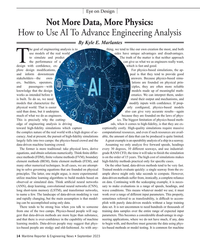 )
September 2023 - Maritime Reporter and Engineering News page: 14
)
September 2023 - Maritime Reporter and Engineering News page: 14Eye on Design Not More Data, More Physics: How to Use AI To Advance Engineering Analysis By Kyle E. Marlantes he goal of engineering analysis is to thing, we tend to like our own creation the most, and both use models of the real world sides have unique advantages and disadvantages. to simulate and
-
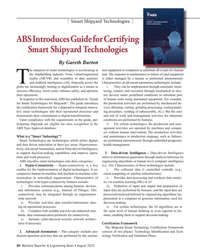 )
August 2023 - Maritime Reporter and Engineering News page: 20
)
August 2023 - Maritime Reporter and Engineering News page: 20Smart Shipyard Technologies ABS Introduces Guide for Certifying Smart Shipyard Technologies By Gareth Burton substituteallorpartofahuman he adoption of smart technologies is accelerating in tion equipment or computers to substitute all or part of a human the shipbuilding industry. From virtual/augmented
-
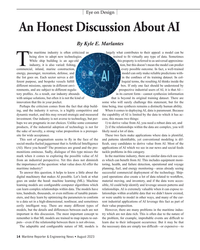 )
August 2023 - Maritime Reporter and Engineering News page: 14
)
August 2023 - Maritime Reporter and Engineering News page: 14Eye on Design An Honest Discussion About AI By Kyle E. Marlantes he maritime industry is often criticized as largely what contributes to their appeal: a model can be being slow to adopt new technologies. trained to ? t virtually any type of data. Sometimes While ship building is an age-old this
-
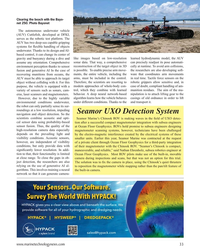 )
July 2023 - Marine Technology Reporter page: 33
)
July 2023 - Marine Technology Reporter page: 33Clearing the beach with the Bayo- net 250. Photo Bayonet The autonomous underwater vehicle (AUV) Cuttle? sh, developed at DFKI, serves as the robotic test platform. The AUV has two deep-sea capable gripping systems for ? exible handling of objects underwater. Thanks to its design and AI- based control
-
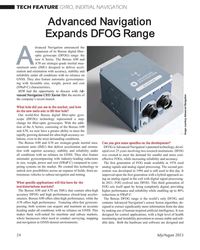 )
July 2023 - Marine Technology Reporter page: 24
)
July 2023 - Marine Technology Reporter page: 24TECH FEATURE GYRO, INERTIAL NAVIGATION Advanced Navigation Expands DFOG Range dvanced Navigation announced the expansion of its Boreas digital ? ber- optic gyroscope (DFOG) range: the new A Series. The Boreas A90 and AA70 are strategic-grade inertial mea- surement units (IMU) designed to deliver
-
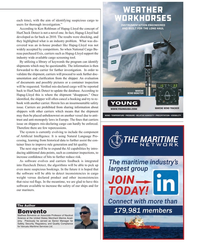 )
June 2023 - Maritime Reporter and Engineering News page: 21
)
June 2023 - Maritime Reporter and Engineering News page: 21each time), with the aim of identifying suspicious cargo to users for thorough investigation.” According to Ken Rohlman of Hapag-Lloyd the concept of HazCheck Detect is not a novel one. In fact, Hapag-Lloyd had developed as far back as 2010. The results were shocking, and they highlighted what is an
-
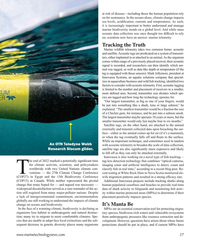 )
May 2023 - Marine Technology Reporter page: 27
)
May 2023 - Marine Technology Reporter page: 27de- cies that are unable to adapt face local extinctions and the sub- velopment. However, questions have arisen about where future sequent decrease in genetic diversity places many organisms protections should be put in place, and if current MPAs have www.marinetechnologynews.com 27 MTR #4 (18-33).indd
-
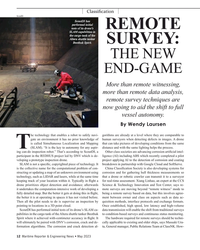 )
May 2023 - Maritime Reporter and Engineering News page: 12
)
May 2023 - Maritime Reporter and Engineering News page: 12Classi? cation ScoutDI ScoutDI has performed initial REMOTE tests of its drone’s SLAM capabilities in the cargo tank of the Altera shuttle tanker Beothuk Spirit. SURVEY: THE NEW END-GAME More than remote witnessing, more than remote data analysis, remote survey techniques are now going to aid
-
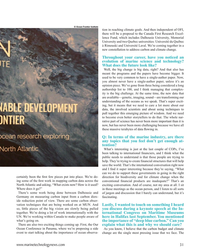 )
March 2023 - Marine Technology Reporter page: 31
)
March 2023 - Marine Technology Reporter page: 31considered a long authorship list to 100, and I think managing that complex- ity is the big challenge. At the same time, the new data that are available—genetic, imaging, sound—are transforming our understanding of the oceans as we speak. That’s super excit- ing, but it means that we need to care a lot more
-
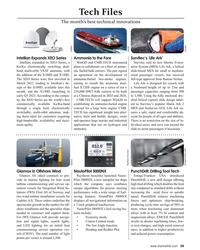 )
February 2023 - Maritime Reporter and Engineering News page: 39
)
February 2023 - Maritime Reporter and Engineering News page: 39Tech Files The month’s best technical innovations WinGD Survitec Intellian Intellian Expands XEO Series Ammonia to the Fore Survitec’s ‘Life Ark’ Intellian expanded its XEO Series, a WinGD and CMB.TECH announced Survitec said its new Marine Evacu- Ku/Ka electronically switching dual- plans to collaborate
